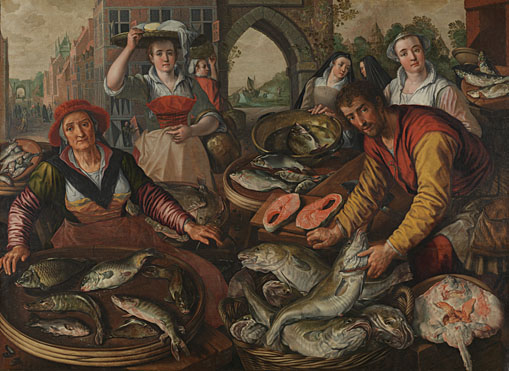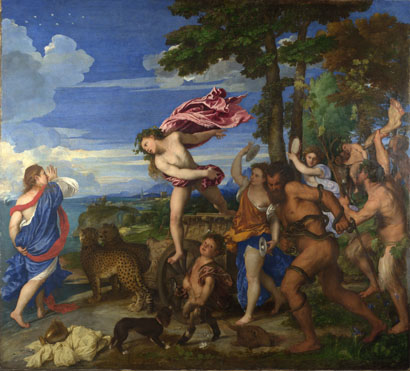At the National Gallery I take a detour to the Sixteenth-Century paintings to indulge my soft spot for Titian, now I feel I have an Italian connection with him. En route I am impressed by El Greco’s The Adoration of the Name of Jesus (1578) – a small canvas packed with detail and symbolism.
Joachim Beuckelaer also seems to know a thing or two about symbolism, with his Four Elements series (1569) which represents said elements with seductive images of market produce. A small scene from the life and teachings of Christ lurks in the background of each picture – he is considered one of the earliest and most accomplished masters of the fusion of the New Testament narrative with everyday life (Beuckelaer that is, not Jesus - although he could probably stake a claim too). These pictures were made quickly with bold and broad brushstrokes. Beuckelaer reveals himself as a skilled colourist – repeating and echoing colours and patterns in order to guide the viewer’s eye across his compositions.
Water features the stallholders with seafood, while Christ in the background appears to the disciples and fills their empty nets with fish. In Earth vegetables tumble from a basket and cascade towards the viewer – the holy family cross a bridge in the background.
Poultry and other skinned haunches of meat are the foreground focus of Fire – a still life with a dramatic construction. Christ is seated with Mary and Martha in the background. The background image in Air is of the prodigal son parable, while the market scene is one of fowl and rabbits (both dead and alive) framed by piles of eggs and stacks of cheeses.
Titian’s An Allegory of Prudence (1565-70) has three faces which represent the past, present and future. Apparently the triple-headed wolf lion and dog stood for prudence in sixteenth-century art and literature – ‘learning from yesterday, today acts prudently, lest by his action he spoil tomorrow’. In his Portrait of a Man (1510-20) the man in question appears to have just turned to face the viewer. His elaborate blue sleeve dominates the picture, protruding over the parapet to enhance the 3D quality of the image. Bacchus and Ariadne (1520-3) is a celebrated work of classical mythology, but I can’t get over the fact that Bacchus looks like he’s bowling down the wicket.
My brain is now full of images, light, perspective and composition. Placement and framing is of utmost importance in these paintings but also, I realise in my photography and, even as I am sated with culture, I am refreshed with themes and ideas.




No comments:
Post a Comment